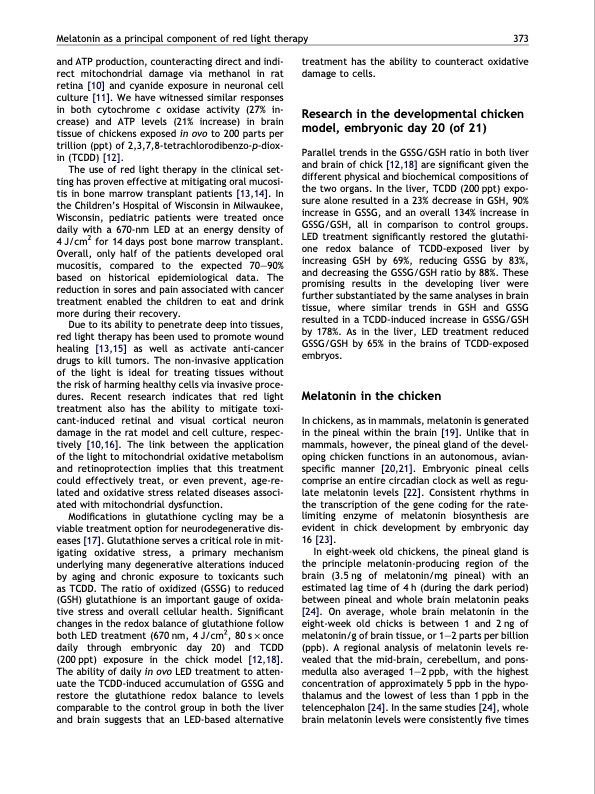
PDF Publication Title:
Text from PDF Page: 003
Melatonin as a principal component of red light therapy 373 and ATP production, counteracting direct and indi- rect mitochondrial damage via methanol in rat retina [10] and cyanide exposure in neuronal cell culture [11]. We have witnessed similar responses in both cytochrome c oxidase activity (27% in- crease) and ATP levels (21% increase) in brain tissue of chickens exposed in ovo to 200 parts per trillion (ppt) of 2,3,7,8-tetrachlorodibenzo-p-diox- in (TCDD) [12]. The use of red light therapy in the clinical set- ting has proven effective at mitigating oral mucosi- tis in bone marrow transplant patients [13,14]. In the Children’s Hospital of Wisconsin in Milwaukee, Wisconsin, pediatric patients were treated once daily with a 670-nm LED at an energy density of 4 J/cm2 for 14 days post bone marrow transplant. Overall, only half of the patients developed oral mucositis, compared to the expected 70–90% based on historical epidemiological data. The reduction in sores and pain associated with cancer treatment enabled the children to eat and drink more during their recovery. Due to its ability to penetrate deep into tissues, red light therapy has been used to promote wound healing [13,15] as well as activate anti-cancer drugs to kill tumors. The non-invasive application of the light is ideal for treating tissues without the risk of harming healthy cells via invasive proce- dures. Recent research indicates that red light treatment also has the ability to mitigate toxi- cant-induced retinal and visual cortical neuron damage in the rat model and cell culture, respec- tively [10,16]. The link between the application of the light to mitochondrial oxidative metabolism and retinoprotection implies that this treatment could effectively treat, or even prevent, age-re- lated and oxidative stress related diseases associ- ated with mitochondrial dysfunction. Modifications in glutathione cycling may be a viable treatment option for neurodegenerative dis- eases [17]. Glutathione serves a critical role in mit- igating oxidative stress, a primary mechanism underlying many degenerative alterations induced by aging and chronic exposure to toxicants such as TCDD. The ratio of oxidized (GSSG) to reduced (GSH) glutathione is an important gauge of oxida- tive stress and overall cellular health. Significant changes in the redox balance of glutathione follow both LED treatment (670 nm, 4 J/cm2, 80 s · once daily through embryonic day 20) and TCDD (200ppt) exposure in the chick model [12,18]. The ability of daily in ovo LED treatment to atten- uate the TCDD-induced accumulation of GSSG and restore the glutathione redox balance to levels comparable to the control group in both the liver and brain suggests that an LED-based alternative treatment has the ability to counteract oxidative damage to cells. Research in the developmental chicken model, embryonic day 20 (of 21) Parallel trends in the GSSG/GSH ratio in both liver and brain of chick [12,18] are significant given the different physical and biochemical compositions of the two organs. In the liver, TCDD (200 ppt) expo- sure alone resulted in a 23% decrease in GSH, 90% increase in GSSG, and an overall 134% increase in GSSG/GSH, all in comparison to control groups. LED treatment significantly restored the glutathi- one redox balance of TCDD-exposed liver by increasing GSH by 69%, reducing GSSG by 83%, and decreasing the GSSG/GSH ratio by 88%. These promising results in the developing liver were further substantiated by the same analyses in brain tissue, where similar trends in GSH and GSSG resulted in a TCDD-induced increase in GSSG/GSH by 178%. As in the liver, LED treatment reduced GSSG/GSH by 65% in the brains of TCDD-exposed embryos. Melatonin in the chicken In chickens, as in mammals, melatonin is generated in the pineal within the brain [19]. Unlike that in mammals, however, the pineal gland of the devel- oping chicken functions in an autonomous, avian- specific manner [20,21]. Embryonic pineal cells comprise an entire circadian clock as well as regu- late melatonin levels [22]. Consistent rhythms in the transcription of the gene coding for the rate- limiting enzyme of melatonin biosynthesis are evident in chick development by embryonic day 16 [23]. In eight-week old chickens, the pineal gland is the principle melatonin-producing region of the brain (3.5ng of melatonin/mg pineal) with an estimated lag time of 4 h (during the dark period) between pineal and whole brain melatonin peaks [24]. On average, whole brain melatonin in the eight-week old chicks is between 1 and 2 ng of melatonin/g of brain tissue, or 1–2 parts per billion (ppb). A regional analysis of melatonin levels re- vealed that the mid-brain, cerebellum, and pons- medulla also averaged 1–2 ppb, with the highest concentration of approximately 5 ppb in the hypo- thalamus and the lowest of less than 1 ppb in the telencephalon [24]. In the same studies [24], whole brain melatonin levels were consistently five timesPDF Image | Melatonin as a principal component of red light therapy

PDF Search Title:
Melatonin as a principal component of red light therapyOriginal File Name Searched:
HenshelMelatoninNIR.pdfDIY PDF Search: Google It | Yahoo | Bing
Cruise Ship Reviews | Luxury Resort | Jet | Yacht | and Travel Tech More Info
Cruising Review Topics and Articles More Info
Software based on Filemaker for the travel industry More Info
The Burgenstock Resort: Reviews on CruisingReview website... More Info
Resort Reviews: World Class resorts... More Info
The Riffelalp Resort: Reviews on CruisingReview website... More Info
| CONTACT TEL: 608-238-6001 Email: greg@cruisingreview.com | RSS | AMP |